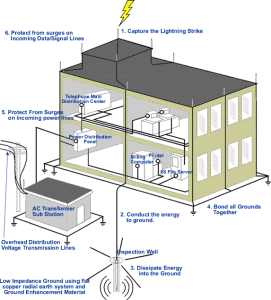Lightning Protection
 The complexity of lightning discharge phenomenon and the difficulties encountered in modeling its events make the field of lightning protection controversial. One fact that researches do agree on is that the frequency and intensity of lightning activity is increasing worldwide and we must provide ourselves with protection from its effects. Lightning theory, like nuclear physics and quantum mechanics, is founded on statistical probabilities based on empirical data collected through years of research. Fortunately, we’re able to define a series of steps required for basic lightning protection that are common to most design concepts. These are:
The complexity of lightning discharge phenomenon and the difficulties encountered in modeling its events make the field of lightning protection controversial. One fact that researches do agree on is that the frequency and intensity of lightning activity is increasing worldwide and we must provide ourselves with protection from its effects. Lightning theory, like nuclear physics and quantum mechanics, is founded on statistical probabilities based on empirical data collected through years of research. Fortunately, we’re able to define a series of steps required for basic lightning protection that are common to most design concepts. These are:
Discharge Collection
A system of air terminals and intercepting conductors mounted on the roof edges and features collect the lightning strike along their conductive surfaces and concentrate the discharge along a common preferred path. When designing such collection systems, we examine the structural and cladding components of the building to determine if they can be used as collection points to reduce installation costs. At this stage of design, we can suggest minor revisions to proposed materials in order to allow their use as adequate intercepting surfaces.
Distribution and Conveyance of Discharge
A system of down conductors is connected to the air terminals and intercepting conductors to form a safe and electrically-continuous path for the lightning strike to be discharged to ground. These down conductors are installed in convenient paths down to grade. Like the discharge collection system, it may be possible to utilize the building’s conductive structural elements to safely guide the lightning strike to ground. We examine the structural elements and their dimensional properties to minimize expenditures for your client. We also review the proposed path and locations of the down conductors for proximity to occupied spaces. A phenomenon known as side-flash or spark-over is a secondary effect that allows a discharge to jump from one conductive surface to another, causing collateral damage or personal injury and death. If we feel that there is a probability of this occuring, we can implement site-specific safety features to reduce the risk.
Dissipation of Discharge
The final step involved in lightning protection involves providing a system of grounding electrodes to guide the lightning strike from the down conductors away from the building and safely into Earth. It’s also important to properly interconnect the lightning protection ground rods to the building’s main and telecommunications ground system to eliminate the possibility of earth loops that can damage sensitive electronic equipment and electrical distribution systems. This is a very important aspect of the system and also the most variable due to the wide range of soil types – each having different electrical characteristics. Once we determine the typical nature of the soil at your proposed site, we have several grounding methods available. In some instances, it is necessary to use an earth enhancing compound to reduce the soil resistance around grounding electrodes. Loamy, shaley, and solid rock conditions each require different grounding methods for maximum effectiveness.
Building Services Protection
All incoming power and telecommunication lines entering the building must also be protected from voltage transients and surges that are capable of destroying distribution and computer equipment. The best way of accomplishing this is to install a cascaded protection system starting from the main service entry and proceeding to the distribution equipment and termination points. This includes telephone coaxial cabling and fiber optic installations. We’ll help your client decide which system of Transient Voltage Surge Suppressors (TVSS) and Line Filters best suit his equipment and budget. See our Power Conditioning service description section for more information.
